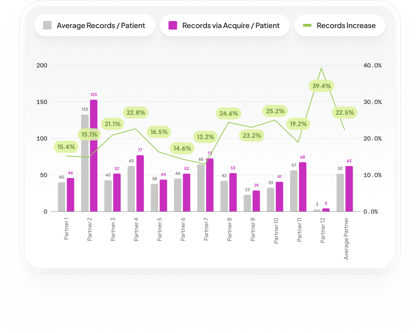"Note Bloat" is a Major Problem. Here's What You Can Do About It

Any healthcare provider can tell you how challenging it is to sift through hundreds of pages of patient medical records. The sheer volume of information about a patient can be incredibly overwhelming, especially for Medicare Advantage providers who often have to navigate decades of patient history.
But here's the thing: not all that information is actually necessary or relevant.
“Note bloat” is an increasingly common phenomenon, where medical records become needlessly lengthy, often due to providers copying and pasting information into patient charts.
This practice not only makes it difficult for healthcare professionals and coders to find the essential details, but it can also lead to potential risks for patients and increased costs for both payers and providers.
So, why does this issue persist, and more importantly, what can we do to address it?
The Copy-Paste Conundrum
It's no secret that many physicians copy and paste information from past medical records directly into current patient charts.
In fact, the University of Pennsylvania Medical Center found that in a study of 100 million notes, more than half of the text was duplicated.
The use of electronic medical records has exacerbated this problem by making it easy for providers to duplicate information with just a few clicks. While this may seem more convenient in the moment than writing out a test result or a progress note, it leads to unnecessarily long records that are full of clutter and difficult to read.
The True Dangers of Note Bloat
Note bloat is more than just an inconvenience, it’s dangerous for patients and for the providers who treat them.
After all, 70% of primary care providers report receiving more patient data than they can effectively manage. And how can someone be expected to adequately treat a patient when they don’t understand their medical history?
The practice of copying and pasting medical record data also makes it much harder to catch typos and other errors, which can be incredibly dangerous to a patient’s health and safety.
Note bloat is an even more serious concern for Medicare Advantage and other value-based care providers, because it makes accurate, compliant risk adjustment nearly impossible.
The more pages of medical records a coder needs to sift through, the more challenging it will be to identify all possible HCC codes.
And when codes are identified, it’s also more difficult to find the appropriate documentation for those codes, which can put you at higher risk of audits and fines.
In these ways, note bloat is actively diminishing VBC providers’ abilities to deliver quality care and generate revenue.

Streamlining and Automating Medical Record Analysis with Credo PreDx
At Credo, we're committed to providing providers with the tools they need to extract essential information from patient medical records, no matter how bloated.
Credo PreDx empowers providers to identify HCC codes faster and more efficiently, and we’re making it possible to do this work before the patient encounter.
Learn more about why pre-encounter risk adjustment is a valuable strategy for VBC providers.
Leveraging the power of AI, we streamline the analysis process, saving you substantial time and money while also improving your coding accuracy and compliance.
Say goodbye to note bloat and embrace a new era of accurate, concise, and efficient medical record documentation. To learn more about how Credo PreDx can transform your risk adjustment process, schedule a demo here.





